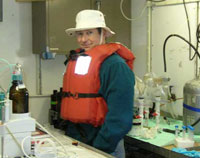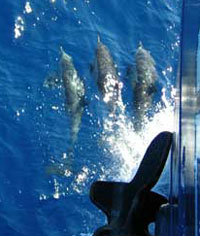


|
The Project Part 1: Part 2: Part 3:
| Daily JournalFebruary 6, 2005:
|
Matt works at keeping the rust at bay.
Brian is ready for anything.
Dolphins ride alongside the bow during the beginning of our trip. |
Tonight we’ll pass around the tip of Baja on our way back home, and we’re preparing for some bumpy weather. In the mean time, the eight days of sampling, experiments and inconsistent sleep schedules has taken their toll. Today the science party is doing a lot of sleeping, watching movies, and even some whale-watching; pretty much anything that involves collapsing someplace comfortable. The process of sorting all the data we’ve collected is also beginning. No doubt tomorrow we’ll start the packing, though at a leisurely pace, as we have three more days of transit before hitting San Diego.
Collectively, there have been over 30 CTD casts, and each one records a number of properties (like temperature, irradiance [a measure of light], and oxygen) during the entire cast. Not only that, all the water that was collected will be used to say something about the ocean and the plants in it—specifically, Emiliania huxleyi. While some of that water has already been analyzed on-board soon after it was collected, a number of samples will be frozen and shipped home to be analyzed there. Chris also has collected water through his own special pump and Go-Flos, which are specially-made to try and exclude any metals from getting into his samples and contaminating them. This is quite an undertaking on board a huge metal ship.
Q: Eduardo told us an interesting thing: A long time ago, the U.S. invaded Mexico, and the Mexicans didn’t want them in their country. The U.S. soldiers were wearing green uniforms, and so the Mexicans yelled “Green, go home! Green, go!” That was how the term ‘gringo’ came into being. Can you think of other terms or slang that were brought about by what was going on at the time?
![]()




